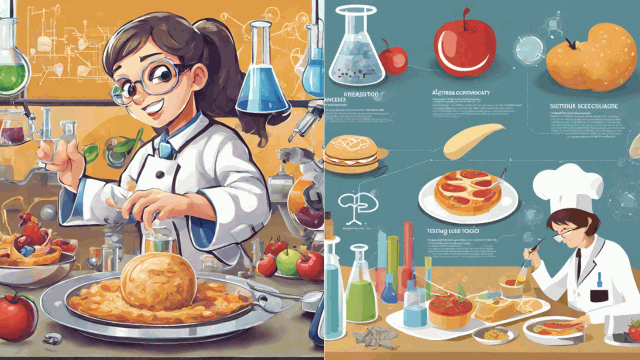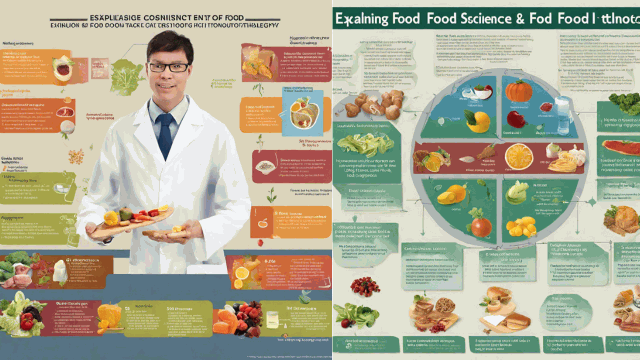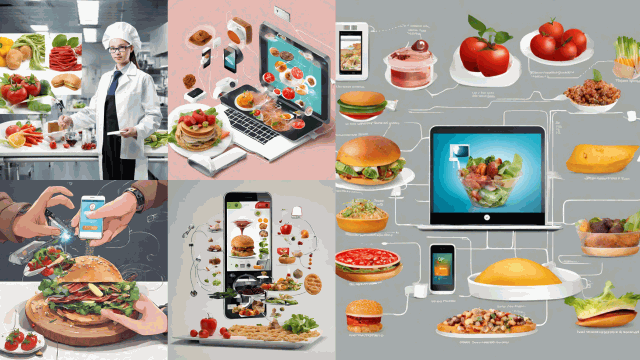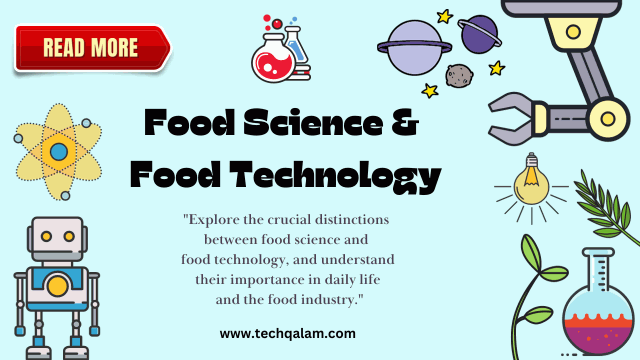Food Science and Food Technology
Preface
Can you respond to a question about “what is science” with precision and without hesitation or delay? Or will it cause you a great deal of mental distress and confusion?
But occasionally, a straightforward inquiry might compel you to consider a number of more difficult ones by opening your eyes.
Such a circumstance will arise when you are instructed to discern between the characteristics of science and technology.

The terms “science” and “technology” are frequently used interchangeably and are invariably connected. Consequently, it can occasionally be challenging to distinguish between these two names.
But there are differences between the ways that science and technology are applied, and one can distinguish between them depending on the situation. Now we’ll look at how food technology differs from food science.
♦ Food science
It is difficult to sum up the word science in one or two words. A few of the basic science disciplines that include multiple sub-divisions are the biological, physical, and chemical sciences.
Food science is an applied science that brings together all of these different areas of study since it is concerned with food. Since technology is an application of science, it also falls within that category.
Therefore, we cannot claim that science is being neglected by technology. Analysts and pioneers in the food business are known as “food researchers.” Specialists and trend-setters in the food business are known as “food researchers.”
♦ Food Technology
Technology results from the application of science at an advanced level. It is sometimes referred to as applied science. People use scientific knowledge to its fullest potential when it is constantly expanding.
The culinary sector is not an exception. They also make an effort to use scientific development for commercial advantage. These applications or advancements can be separated into subfields like food handling innovation, food capacity innovation, and food conservation innovation.
Food technology includes all the technologies utilized from the time crops are harvested until they are consumed. Pasteurization, packing, freezing, chilling, and dehydration are a few of the processes utilized in food preservation.
One application of technology is called a technique. Analytical, separation, vacuum packing, and modified atmospheric procedures are a few of them.
♦ What distinguishes food science and food technology, precisely?

◊ Food science and food technology are similar topics, yet they differ in some ways
The expression “food science” alludes to the scholarly discipline that examines the fixings, planning, and capacity of food. Researchers who concentrate on food utilize that information to foster new food sources and upgrade the nature of those generally available.
They may likewise investigate the taste, surface, and presence of food varieties to track down ways of upgrading those viewpoints.
◊ Food scientists are often educated in chemistry, biology, or microbiology
Food technology, on the other hand, is the use of food science to manufacture, preserve, package, and distribute food items. Food technologists are liable for interpreting food researchers’ innovative work into business items.
They are accountable for making new food items, working on old ones, and guaranteeing that food is protected and meets quality guidelines. Food technologists are often educated in food science or food engineering.
“Food science is a logical discipline that produces realities, techniques, and, in the long run, information, though food innovation is the utilization of that data in the assembling and handling of business food items.
Both are significant in the food area, yet they have various foci and request different ranges of abilities”.
♦ Why should you study food technology and science?
There are five reasons to select food science and food technology
◊ Work Security
Without food, there could be no life. Consequently, the food business will keep processing food and employing people.
◊ Different Environment
There are dozens of alternatives available to aspiring food scientists and technologists due to the food industry’s extreme diversity.
A few possible careers are those in the fields of milk processing, winemaking, baking, meat processing, flavor production, and so forth. Multidisciplinary course study opens up a world of opportunities.
◊ Income Possibilities
A food science degree can lead to a number of well-paying positions with a rapid growth rate.
◊ Meal
If you have a passion for cooking, a career in the restaurant business would be your ideal job. Delicious meals will be served to you as you develop and test new items. Additionally, you’ll get to sample a variety of cuisines and flavors.
◊ Chances to Travel
Most food enterprises operate internationally. Depending on your profession, you might have the chance to travel to other countries for work, training, or business expansion.

♦ Importance of Food Science and food technology Studies
The study of integrated research in basic science, microbiology, biochemistry, nutrition, biotechnology, and engineering for the creation and administration of food resources is known as food science and technology.
The characteristics, content, and behavior of food products during processing, handling, storing, distributing, and using are revealed by this field. In order to satisfy the expanding expectations of today’s markets, food science is essential.
The need for particular recipes and foods, such as low-fat, low-carb, and low-sugar options, is driving the growth of the food science sector.
The goal of food scientists’ research is to comprehend the molecular makeup of the freshest ingredients. Most food comes from organic sources.
It’s a complicated matter how they act when being harvested, processed, distributed, stored, and prepared. A thorough understanding of the issue is necessary in order to completely identify all of its significant components.
The vast majority of shoppers worldwide aimlessly browse the grocery aisles, grabbing items from the shelves. Seldom do people pause to consider the transportation of food products.
However, the same reason food science is so vital is the reason it’s available.
♦ Why are food science and food technology important in daily life?
Six reasons why food science and food technology are important in daily life are stated below.
- Making sure food is secure and safe
- Innovation in the culinary industry
- Provides workers in the field with a large selection of jobs.
- It prevents food processing companies from losing money.
- Convert uncooked food into a completed, delectable, and visually appealing product.
- Food science: simplifying life
♦ Importance of Food Science and food Technology
◊ Guaranteeing food security and safety
Food science ensures that foods intended for human consumption are always safe and accessible. You really don’t want food poisoning if you have never had it.
You will never want it again once you have it. Thankfully, experts are employed to guarantee food safety and quality standards, lowering the risk of food poisoning. Within the public sector, this is typically a fairly severe responsibility.
Given that people’s health and lives are in danger, a thorough understanding of food safety standards and the science underlying them is essential to accurately identifying contamination hazards and the situations that must be avoided. have to complete it.
In order to develop new foods, enhance food systems, and acclimate staff members to an environment that safeguards the integrity and security of the world’s food supply chain, Food Science and Technology depend on science and technology.
Food scientists and technologists who are skilled in applying a broad spectrum of scientific knowledge to maintain a high-quality and plentiful food supply can contribute to providing this abundance.
It is feasible to maximize food resources and reduce waste thanks to food science.
◊ Innovation in the Food Industry
Food scientists and engineers work in fields where scientific and technological advancements collide. Over the years, as civilization has changed, our food system has advanced significantly to become a massively complex worldwide system.
A versatile, cross-disciplinary, and cooperative professional. Due to the rapid expansion of the food system, the system of today is different from one that was centered on the production and storage of home foods on private farms.
Food science has provided us access to nutritious new foods, easier-to-prepare classic foods, frozen and canned foods, microwave dinners, milk that keeps, snacks, and most importantly, variety in our diets.
◊ Provides a Variety of Jobs to Individuals in the Field
Numerous fields in the food industry are available to those with a certificate in food science and technology.
Graduates with a certificate in food science and technology can find employment in a wide range of industries in addition to creating high-quality, reasonably priced, and safe food for the general public.
A purchasing manager, Toxicologist, a product developer, a quality assurance manager, and a food scientist or Food Science Technician are a few examples.
◊ Avoid Food Processing Companies from Losing Money
Lack of trained food scientists to oversee manufacturing causes the majority of food processing businesses to fail.
Entrepreneurs in the food processing and allied industries hire experts in food science and technology to validate and test products intended for human consumption.
Before being permitted for ingestion, any food intended for distribution to the general public must satisfy a set of acceptable standards.
Should those requirements not be met, the product will be rejected. Before a product is put on the market, the company’s food experts make sure it satisfies their acceptable requirements for microbial contamination, calorie content, protein content, sugar content, antioxidant content, and other factors.
◊ Convert Raw Materials into a Finished, Taste-Full, and Attractive Product
Researchers in the field of food science examine and evaluate various processing and storage techniques. These include, to mention a few, canning, pasteurization, freezing, and drying.
By doing this, scientists find innovative methods for transforming raw materials into finished goods without destroying useful nutrients, guaranteeing that consumers will always enjoy and taste the greatest food available on the market.
For instance, food science research has made it possible for us to turn raw maize into infant feeds like “cerelac” and fruits into fruit juices and other products.

FAQs about Food Science and Food Technology
👉 Is there a difference between food science and food technology?
The study of food is known as nutrition science. Food scientists investigate the food supply by analyzing its structure, microbes, and chemicals. Safe food is selected, conserved, processed, packaged, delivered, and consumed with the help of food science, which is utilized in food technology.
👉 Just what does the study of food entail?
Restaurants, hospitals, soft drink factories, cereal and rice mills, catering companies, quality control departments, packaging firms, and academic institutions are just some of the places where graduates and postgraduates in food technology can find employment.
👉 Where do you see food science and food technology going from here?
In the near future, it is expected that the use of simulation, artificial intelligence, and machine learning techniques (along with the use of IoT and big data utilization) will improve food safety, quality assurance, and productivity in the context of food processing and food science and technology.
👉 How does one define food technology as opposed to food science?
Technology is one of the key foci of scientific study. Technology is the application of the knowledge gained from the field of food science, which describes the behavior of different food components.
Scientists that specialize in food are called “food scientists,” while “food technologists” are responsible for introducing novel technologies to the food industry.
👉 How do we know that food science and food technology are related?
The study of food is known as nutrition science. Food scientists investigate the food supply by analyzing its structure, microbes, and chemicals.
Safe food is selected, conserved, processed, packaged, delivered, and consumed with the help of food science, which is utilized in food technology.
Final Thoughts
In conclusion, the fields of food science and food technology are dynamic and ever-evolving, touching on many facets of human existence.
They play a crucial role in establishing a future for the food business that is healthy, environmentally friendly, and free of harmful chemicals.
For the complex food problems of the 21st century to be solved, research, collaboration, and teaching in these areas must continue unabated.
Get access all prompts: https://shortin.com/xyz







